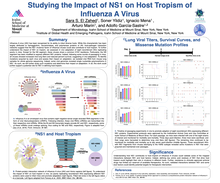Studying the impact of NS1 on host tropism of influenza A virus
Lisa Bauer
Influenza A viruses have the remarkable ability to infect a wide range of hosts. While the viral hemagglutinin, neuraminidase, and polymerase proteins have traditionally taken the spotlight, Sara’s research aims to shed light on the contribution of NS1 on the host tropism as well as the virulence. Sara generates recombinant viruses in the H1N1 backbone which differ in their NS segment and infected mice with these recombinant viruses, which initially replicated poorly in mice. When passaging viruses derived from the lung of infected mice to naive mice, these viruses developed a more virulent phenotype over time. Analysis of the whole genome sequences of some of these viruses unveiled the presence of nonsynonymous single nucleotide polymorphisms (SNPs) within the NS1 gene and several SNPs were fixed during the course of passaging. Mutations in the NS1 mapped to the RNA binding domain as well as to the nuclear localization signal. Further research aims to investigate the impact of these mutation on the adaptation in mice. Furthermore, functional characterization and molecular characterization on the NS1 function itself are ongoing.
| File | Type | Size |
|---|---|---|
| poster632.pdf | Adobe Portable Document Format | 1.1 MB |
